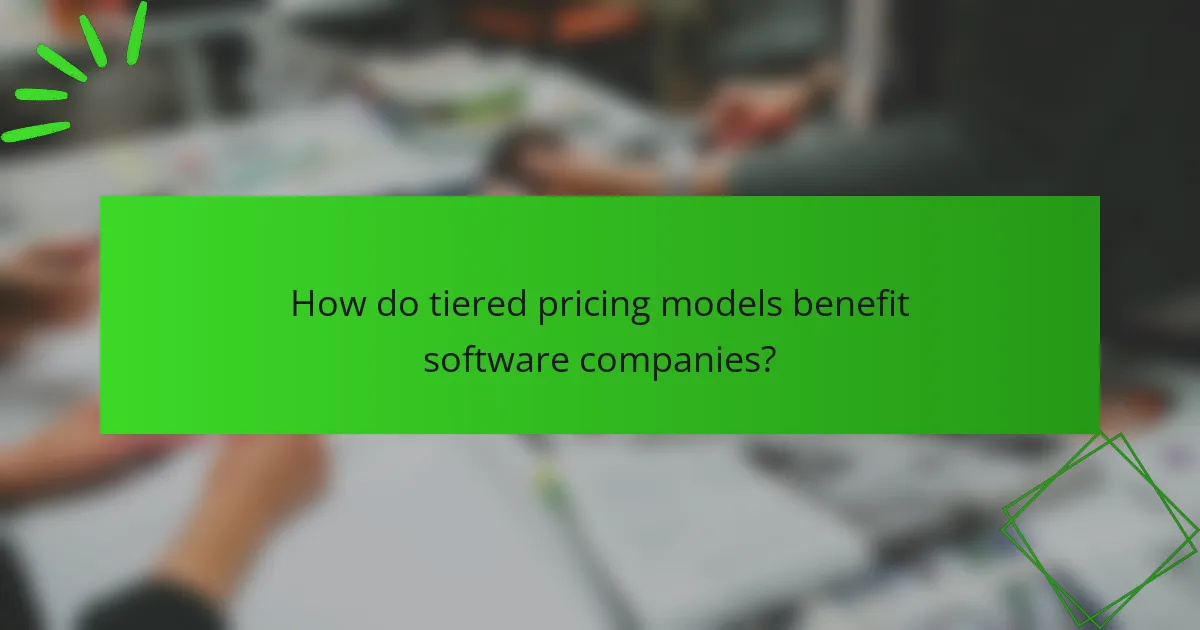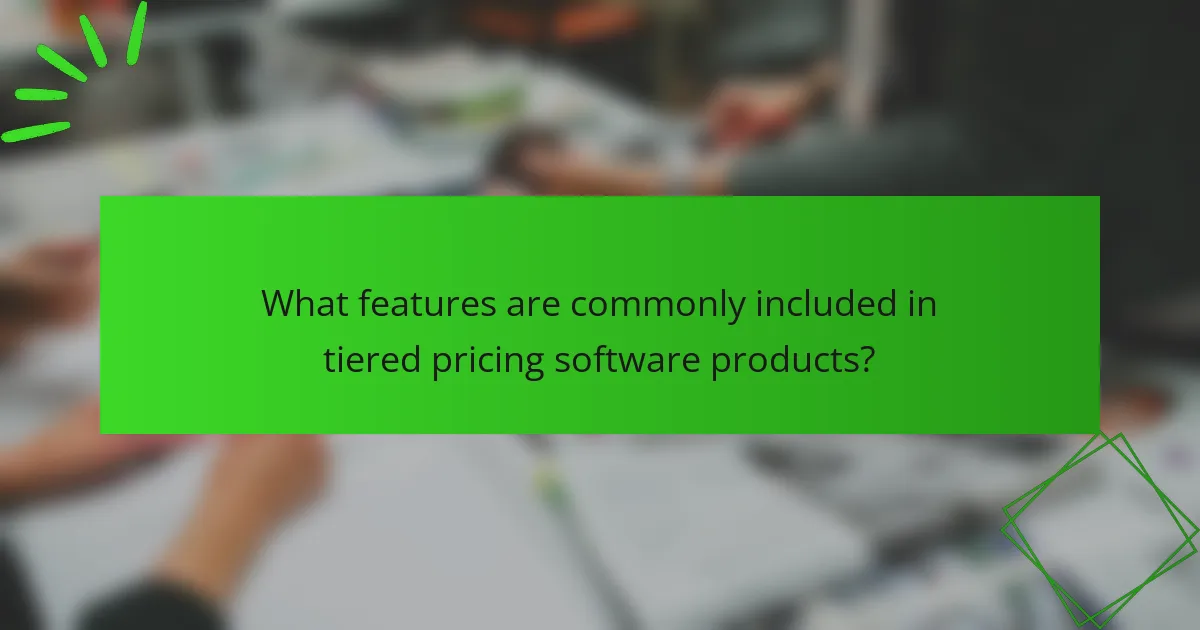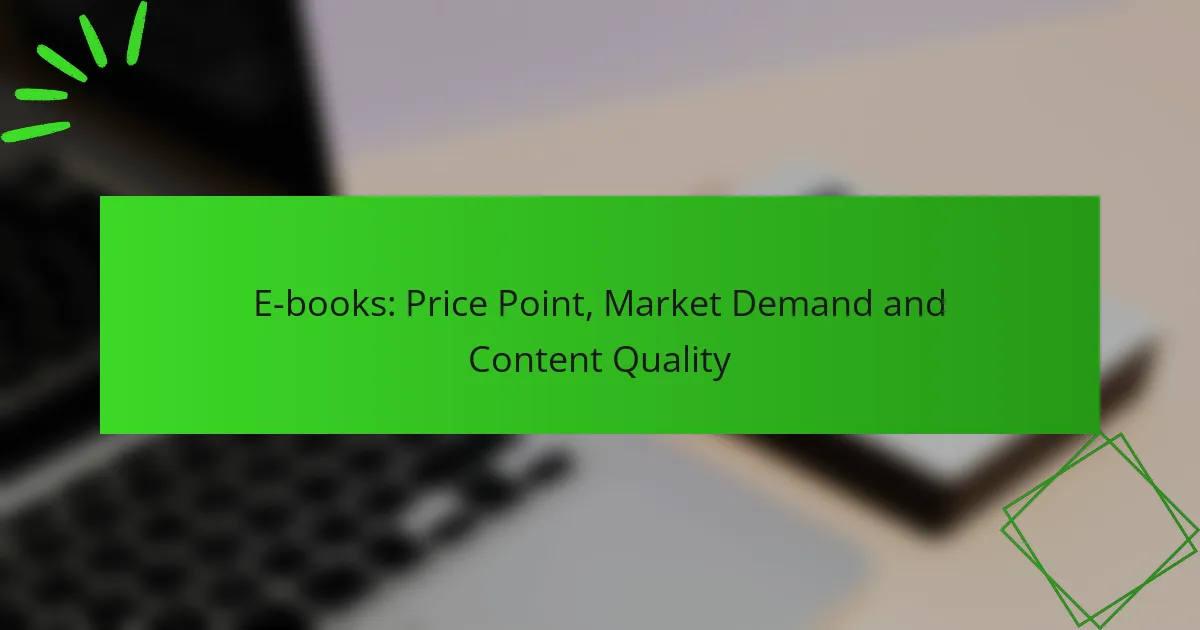Tiered pricing models for software products provide flexible pricing structures that cater to diverse customer needs and usage levels. By offering a range of options from free access to premium features, businesses can attract a wider audience and encourage upgrades as users’ requirements evolve.

What are the tiered pricing models for software products in Canada?
Tiered pricing models for software products in Canada offer various pricing structures that cater to different customer needs and usage levels. These models allow businesses to attract a broader audience by providing options that range from free access to premium features, enabling users to choose a plan that fits their requirements and budget.
Freemium model
The freemium model provides basic software features at no cost while charging for advanced functionalities. This approach allows users to experience the product without financial commitment, which can lead to higher conversion rates as they become familiar with the software.
Common examples include cloud storage services that offer limited free storage space, encouraging users to upgrade for additional capacity. Businesses should ensure that the free version is valuable enough to attract users while clearly communicating the benefits of the paid tiers.
Subscription model
The subscription model charges users a recurring fee, typically monthly or annually, for continued access to the software. This model provides predictable revenue for companies and often includes tiered pricing based on features or usage levels.
For instance, a software service might offer basic, standard, and premium plans, with each tier providing additional features or support. Companies should consider offering discounts for annual subscriptions to encourage long-term commitments from users.
Pay-per-use model
The pay-per-use model charges customers based on their actual usage of the software, making it suitable for businesses that have fluctuating needs. This model allows users to pay only for what they consume, which can be cost-effective for those who do not require constant access.
Examples include software that charges based on the number of transactions processed or data stored. Businesses should clearly outline pricing structures and usage limits to avoid unexpected charges for users.
Enterprise pricing model
The enterprise pricing model is tailored for large organizations and typically involves custom pricing based on specific needs, such as user count, features, and support levels. This model allows software providers to negotiate terms that align with the scale and requirements of the enterprise.
Companies should conduct thorough assessments of the enterprise’s needs to create a compelling proposal that highlights the value of the software. Providing dedicated support and customization options can enhance the attractiveness of this pricing model.

How do tiered pricing models benefit software companies?
Tiered pricing models offer software companies a strategic way to maximize revenue by catering to different customer needs and budgets. By segmenting their offerings, companies can attract a wider range of users and encourage upgrades as customers grow or require more features.
Increased revenue potential
Tiered pricing can significantly enhance revenue potential by allowing companies to capture more value from various customer segments. For instance, a basic plan may attract cost-conscious users, while premium tiers can appeal to businesses needing advanced features. This structure encourages upselling, as customers may start with a lower tier and upgrade as their needs evolve.
Companies often see revenue growth by offering additional features at higher tiers, which can lead to increased customer lifetime value. For example, a software product might charge $10 per month for basic access, $30 for a standard plan, and $50 for a premium option, enticing users to choose higher tiers for added functionality.
Customer segmentation
Tiered pricing allows software companies to effectively segment their customer base, tailoring offerings to meet diverse needs. By analyzing user behavior and preferences, companies can create specific tiers that resonate with different market segments, such as startups, small businesses, and enterprises.
This segmentation helps in targeting marketing efforts more efficiently. For instance, a company might promote its basic tier to individual users while focusing on the premium tier for larger organizations that require extensive support and features.
Flexibility for users
Offering tiered pricing provides flexibility for users, enabling them to select a plan that aligns with their current requirements and budget. This adaptability is crucial in a competitive software landscape, as it allows customers to choose plans that best fit their needs without feeling locked into a single option.
Moreover, as businesses grow or their needs change, they can easily transition to higher tiers. This seamless upgrade path not only enhances customer satisfaction but also fosters loyalty, as users appreciate the ability to scale their software solutions in line with their evolving demands.

What features are commonly included in tiered pricing software products?
Tiered pricing software products typically include a range of features designed to accommodate different customer needs and pricing strategies. Common features often encompass basic functionalities, advanced analytics capabilities, and various customer support options to enhance user experience and operational efficiency.
Basic features
Basic features in tiered pricing software usually include user-friendly dashboards, pricing tier management, and billing automation. These functionalities allow businesses to easily set up and modify pricing structures based on customer segments, ensuring flexibility in pricing strategies.
Additionally, many software products offer integration with payment gateways to streamline transactions. This can help businesses manage subscriptions and recurring payments effectively, reducing administrative overhead.
Advanced analytics
Advanced analytics features provide insights into customer behavior and pricing performance. These tools often include reporting capabilities that allow businesses to track sales trends, customer acquisition costs, and churn rates across different pricing tiers.
Some software may also offer predictive analytics, helping businesses forecast revenue and optimize pricing strategies based on historical data. This can be particularly useful for identifying which tiers are most profitable and adjusting offerings accordingly.
Customer support options
Customer support options in tiered pricing software can vary widely, ranging from basic email support to comprehensive live chat and phone assistance. Many providers offer a knowledge base or FAQ section to help users troubleshoot common issues independently.
It’s advisable to choose software that includes robust customer support, especially for businesses that rely heavily on pricing strategies. Quick response times and knowledgeable support staff can significantly enhance the user experience and minimize disruptions in service.

Which customer segments are targeted by tiered pricing software?
Tiered pricing software primarily targets small businesses, mid-sized enterprises, and large corporations, each with distinct needs and budgets. This model allows companies to offer varying levels of service and features based on customer requirements, maximizing both accessibility and profitability.
Small businesses
Small businesses often seek tiered pricing software to manage costs while accessing essential features. Typically, they may choose a basic plan that includes core functionalities at a lower price point, which helps them scale without significant upfront investment.
When selecting tiered pricing options, small businesses should consider their growth trajectory and customer base. A plan that allows for easy upgrades as their needs evolve can prevent future disruptions and ensure continued service alignment.
Mid-sized enterprises
Mid-sized enterprises generally require more advanced features and greater customization than small businesses. They often opt for mid-tier plans that provide additional functionalities, such as enhanced analytics and integrations with other tools, which can improve operational efficiency.
These businesses should evaluate their specific needs and the potential return on investment when choosing a tiered pricing model. Engaging with vendors to understand the scalability of features and support options is crucial for long-term success.
Large corporations
Large corporations typically utilize tiered pricing software to manage complex operations and diverse customer needs. They often select premium plans that include extensive features, dedicated support, and custom solutions tailored to their unique business processes.
For these organizations, it is essential to conduct a thorough analysis of their requirements and the potential benefits of each tier. Negotiating contracts for volume discounts or additional services can lead to significant savings and enhanced service delivery.

What criteria should businesses consider when choosing a tiered pricing model?
Businesses should consider factors such as customer needs, product features, and market competition when selecting a tiered pricing model. Understanding these criteria helps ensure that the pricing structure aligns with both customer expectations and business objectives.
Target audience needs
Identifying the target audience’s needs is crucial for effective tiered pricing. Businesses should analyze customer segments to determine their willingness to pay, preferences for features, and usage patterns. For instance, a software product may appeal to small businesses looking for basic functionality, while larger enterprises may require advanced features and support.
To align pricing tiers with audience needs, consider conducting surveys or interviews to gather insights. This feedback can guide the development of features that resonate with different segments, ensuring that each tier offers appropriate value. For example, a basic tier might include essential tools, while higher tiers could offer premium features like analytics and dedicated support.










